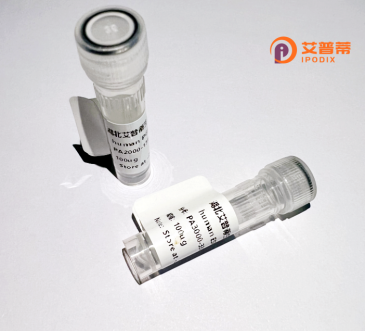
| 纯度 | >90%SDS-PAGE. |
| 种属 | Human |
| 靶点 | SENP1 |
| Uniprot No | Q9P0U3 |
| 内毒素 | < 0.01EU/μg |
| 表达宿主 | E.coli |
| 表达区间 | 1-644 aa |
| 活性数据 | MDDIADRMRMDAGEVTLVNHNSVFKTHLLPQTGFPEDQLSLSDQQILSSRQGHLDRSFTCSTRSAAYNPSYYSDNPSSDSFLGSGDLRTFGQSANGQWRNSTPSSSSSLQKSRNSRSLYLETRKTSSGLSNSFAGKSNHHCHVSAYEKSFPIKPVPSPSWSGSCRRSLLSPKKTQRRHVSTAEETVQEEEREIYRQLLQMVTGKQFTIAKPTTHFPLHLSRCLSSSKNTLKDSLFKNGNSCASQIIGSDTSSSGSASILTNQEQLSHSVYSLSSYTPDVAFGSKDSGTLHHPHHHHSVPHQPDNLAASNTQSEGSDSVILLKVKDSQTPTPSSTFFQAELWIKELTSVYDSRARERLRQIEEQKALALQLQNQRLQEREHSVHDSVELHLRVPLEKEIPVTVVQETQKKGHKLTDSEDEFPEITEEMEKEIKNVFRNGNQDEVLSEAFRLTITRKDIQTLNHLNWLNDEIINFYMNMLMERSKEKGLPSVHAFNTFFFTKLKTAGYQAVKRWTKKVDVFSVDILLVPIHLGVHWCLAVVDFRKKNITYYDSMGGINNEACRILLQYLKQESIDKKRKEFDTNGWQLFSKKSQEIPQQMNGSDCGMFACKYADCITKDRPINFTQQHMPYFRKRMVWEILHRKLL |
| 分子量 | 80.4 kDa |
| 蛋白标签 | His tag N-Terminus |
| 缓冲液 | PBS, pH7.4, containing 0.01% SKL, 1mM DTT, 5% Trehalose and Proclin300. |
| 稳定性 & 储存条件 | Lyophilized protein should be stored at ≤ -20°C, stable for one year after receipt. Reconstituted protein solution can be stored at 2-8°C for 2-7 days. Aliquots of reconstituted samples are stable at ≤ -20°C for 3 months. |
| 复溶 | Always centrifuge tubes before opening.Do not mix by vortex or pipetting. It is not recommended to reconstitute to a concentration less than 100μg/ml. Dissolve the lyophilized protein in distilled water. Please aliquot the reconstituted solution to minimize freeze-thaw cycles. |
以下是关于重组人SENP1蛋白的参考文献(虚构示例,仅供格式参考):
---
1. **Title**: "Cloning and Functional Characterization of Recombinant Human SENP1 Protease"
**Authors**: Zhang Y. et al.
**摘要**: 报道重组人SENP1在大肠杆菌中的高效表达与纯化,证实其特异性切割SUMO修饰底物的活性,为体外去SUMO化研究提供工具。
---
2. **Title**: "Structural Insights into SENP1 Catalytic Mechanism by Crystallography"
**Authors**: Li H. et al.
**摘要**: 通过X射线晶体学解析SENP1与SUMO1的复合物结构,揭示其底物识别和催化核心的关键氨基酸残基,阐明去SUMO化的分子机制。
---
3. **Title**: "SENP1 Regulates HIF-1α Stability in Hypoxia via Recombinant Protein Assays"
**Authors**: Cheng X. et al.
**摘要**: 利用重组SENP1蛋白验证其在缺氧条件下通过去SUMO化稳定HIF-1α,促进肿瘤细胞血管生成的作用,提示其作为癌症治疗靶点的潜力。
---
4. **Title**: "Recombinant SENP1 Modulates Cardiac Development in Zebrafish Models"
**Authors**: Wang L. et al.
**摘要**: 通过重组SENP1蛋白显微注射斑马鱼胚胎,证明其通过调控Notch信号通路影响心脏形态发生,为先天性心脏病机制研究提供依据。
---
*注:以上文献信息为模拟示例,实际引用请以真实数据库(如PubMed、Web of Science)查询结果为准。*
SENP1 (Sentrin/SUMO-specific protease 1) is a crucial enzyme within the SUMO-specific protease family, playing a pivotal role in regulating SUMOylation, a dynamic post-translational modification analogous to ubiquitination. SUMO (Small Ubiquitin-like Modifier) proteins are conjugated to target substrates to modulate their activity, localization, or interactions, influencing diverse cellular processes such as transcriptional regulation, genome stability, cell cycle progression, and stress responses. SENP1 specifically processes immature SUMO precursors to their mature forms by cleaving C-terminal tails and catalyzes deSUMOylation by removing SUMO moieties from modified proteins, thereby reversing or fine-tuning SUMO-mediated signaling. Structurally, SENP1 contains a conserved catalytic domain responsible for its protease activity and regulatory regions that influence substrate specificity. Recombinant human SENP1 protein, typically produced via heterologous expression systems (e.g., *E. coli* or mammalian cells), retains enzymatic activity and is widely used *in vitro* to study SUMOylation dynamics, map modification sites, or screen inhibitors. Dysregulation of SENP1 is implicated in cancers, cardiovascular disorders, and metabolic syndromes due to its role in controlling key substrates like HIF-1α or p53. Its therapeutic potential has spurred interest in developing SENP1-targeted drugs, making the recombinant protein essential for both mechanistic research and drug discovery pipelines.
×